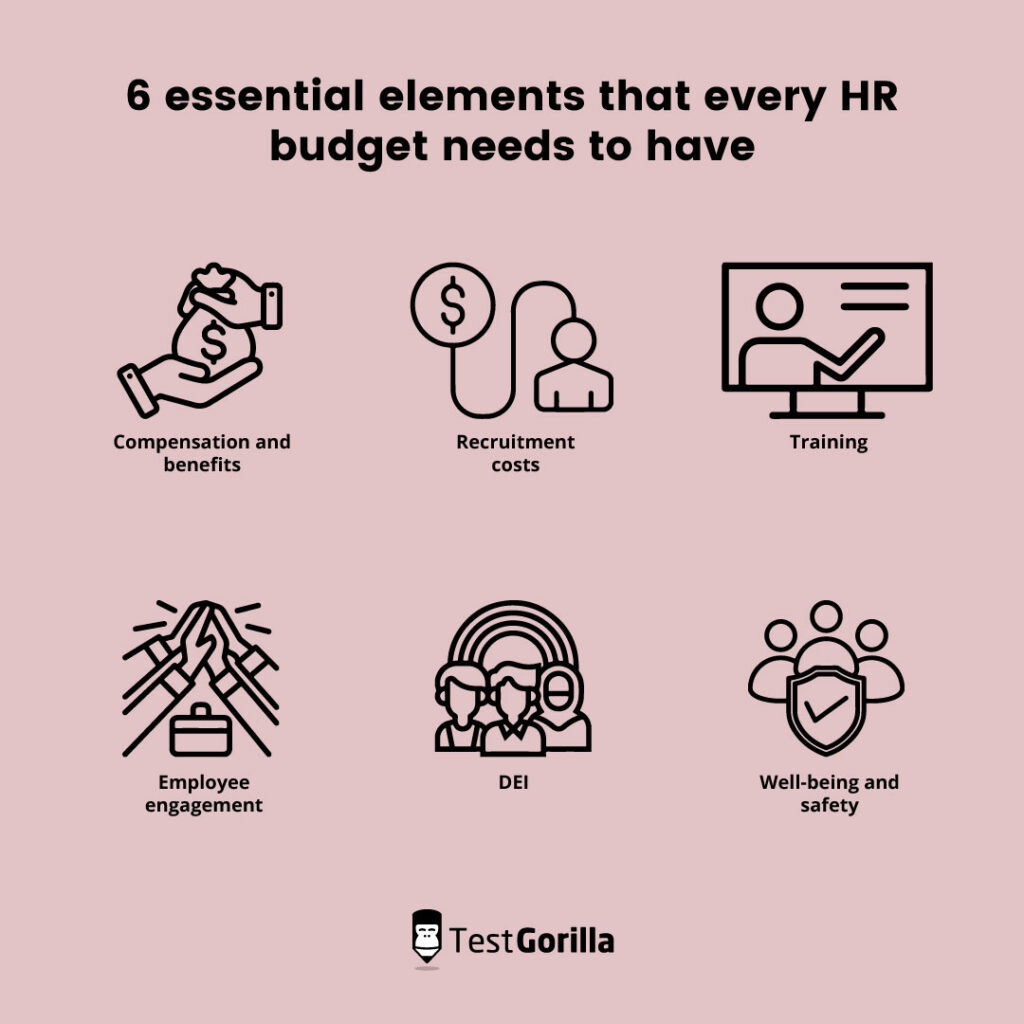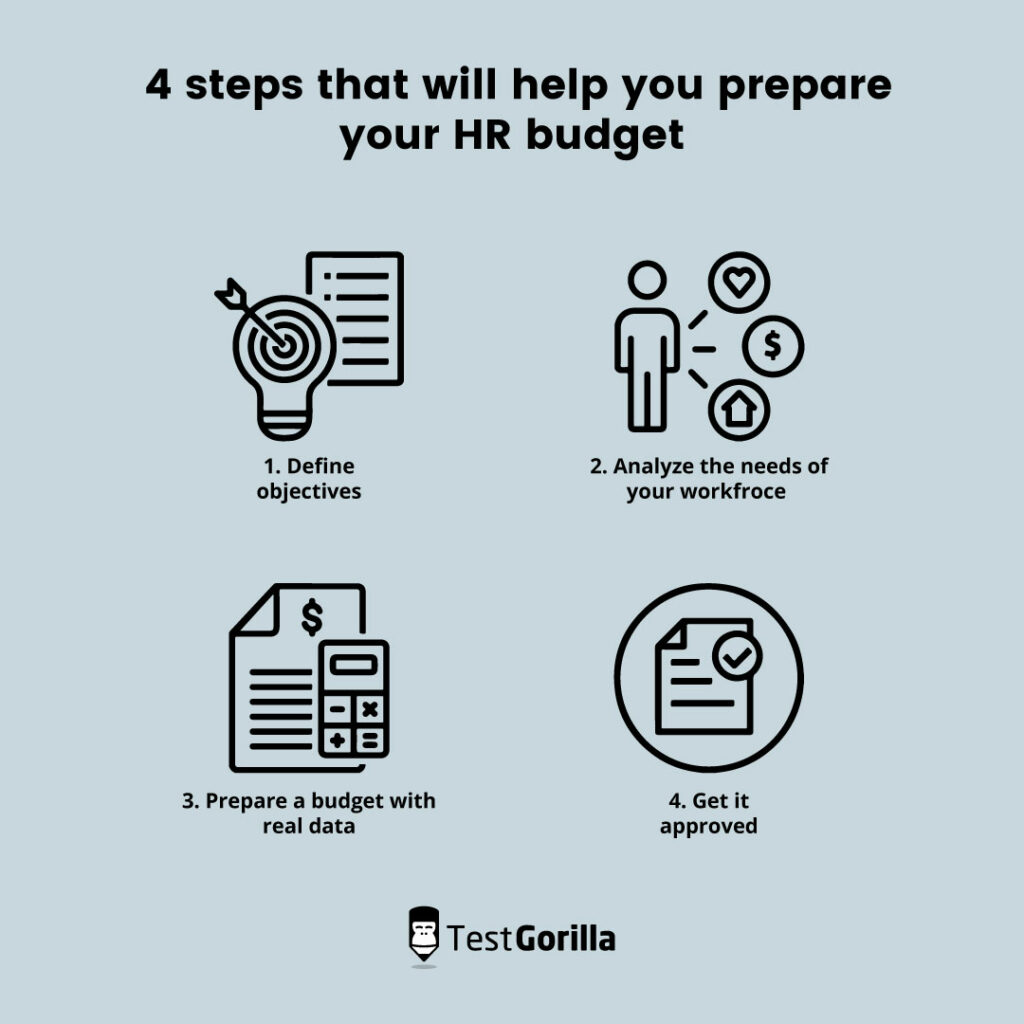A strong HR team is key for any business that wants to grow consistently. HR is in charge of multiple essential elements in an organization such as recruitment, payroll, employee engagement, and employee relations.
And all of these functions can’t be properly executed without a well-defined HR budget.
Pro tip: If you want to make sure that your next HR manager has strong budgeting skills, you can use our Budgeting test during recruitment.
An HR budget will help the HR team analyze their needs and expenses and plan the year ahead. And this article will help you define your HR budget the right way.
Table of contents
The why, how, and what of an HR budget
Every HR budget has a couple of elements that the HR team needs to get right; we’ll go over every single one of them. But first, let’s take a look at what an HR budget actually is.
What is an HR budget?
An HR budget is a collection of funds the HR team uses in a single year to cover all planned activities.
Every business needs to understand that HR executes many fundamental activities that support the functioning of the entire organization. So, if the HR department can’t do that (due to a limited budget or a lack of financial planning), then the entire organization can be in a lot of trouble.
With a well-defined HR budget, key stakeholders at your organization have sufficient visibility into:
The HR team’s yearly plans
All associated costs
An HR budget is therefore indispensable for the functioning of the HR team and the organization.
The 3 benefits of having an HR budget
There are many benefits to having an HR budget and the following three are just the ones that provide the biggest return on investment. A well-defined HR budget enables you to:
Plan your recruitment in advance: When you create an HR budget, you allocate funds for recruitment. This way, you’re able to plan how many people you need to hire in the following year and how much this’ll cost. If you don’t define an HR budget, it’s easy to see your recruitment costs skyrocket simply because you hire too many people or fail to plan in advance. Or you could make the mistake of not allocating enough funds for recruitment and then struggle with talent shortages that limit your operations and business growth.
Attract the right people and reduce your turnover rate: Having a sufficient HR budget will help you target the right people with your recruitment efforts. This, in turn, will help you reduce the turnover rate in your company and strengthen your company culture.
Receive the necessary funding: Like with any business unit, in HR, too, having a budget enables you to ask for (and receive) the funds you need to successfully accomplish your goals.
6 essential elements that every HR budget needs to have
An HR budget can have many elements, but the following six are fundamental for every organization and HR department:
Compensation and benefits: Your HR budget will need to include compensation (salaries) for all employees and benefits costs, such as health insurance and retirement plan contributions.
Recruitment costs: You need to define all recruitment costs the HR department will have in the following year.
Training: Training costs cover the learning and development of every single employee in the company.
Employee engagement: Having a dedicated budget for employee engagement enables you to foster stronger relationships within teams and to connect employees with the company’s vision and purpose.
DEI: On top of recruitment costs, the HR team is also in charge of ensuring that the company invests in diversity and inclusion.
Well-being and safety: Last but not least, an HR budget covers costs related to employees’ well-being and general safety at work.
The 2 types of HR budgets
When planning an HR budget, there are two ways you can approach this:
Incremental budget
With an incremental budget, you need to look at the previous year and your previous HR budget and make incremental changes to specific items.
Find the items that you’ll need to put on this year’s HR budget, as well. Decide whether each item needs more, less, or the same amount of funding as the previous year as you put it on your HR budget. This is usually how large enterprises handle their HR budgets.
Zero-based budget
A zero-based budget is like a clean slate, where the team sits down and writes every single item that they want to be included in the budget. They don’t take items from the last year but analyze every single need they will have in the following year and only write those items down in the HR budget. This is an approach more suited for startups and small companies.
4 steps that will help you prepare your HR budget
When creating an HR budget, the following four steps can help you create a streamlined process:
Define objectives: The first thing you need to do is to define your HR objectives for the following year.
Analyze the needs of your workforce: The second element you need to take into account is your workforce needs. You will need to ensure that your employees are satisfied with the growth opportunities they have at your company and that you can keep turnover rates low.
Prepare a budget with real data: The third step is to analyze the needs of your workforce and your objectives in parallel and prepare a budget. Make sure to use as much data as possible: This will help you get your budget approved.
Get it approved: The last step is to get your budget approved. It’ll probably undergo a few corrections, but if you’re able to back up your requests with data, you should be fine.
HR budget: a must for every HR team
Executing strategic HR functions like recruitment requires you to have a well-planned-out HR budget. And if you’re struggling to define your recruitment budget, read our article on the 6 essential things that you need for an effective recruiting budget and make sure to include those elements in your HR budget.
Related posts
Hire the best candidates with TestGorilla
Create pre-employment assessments in minutes to screen candidates, save time, and hire the best talent.
Latest posts
The best advice in pre-employment testing, in your inbox.
No spam. Unsubscribe at any time.

Hire the best. No bias. No stress.
Our screening tests identify the best candidates and make your hiring decisions faster, easier, and bias-free.
Free resources
This checklist covers key features you should look for when choosing a skills testing platform
This resource will help you develop an onboarding checklist for new hires.
How to assess your candidates' attention to detail.
Learn how to get human resources certified through HRCI or SHRM.
Learn how you can improve the level of talent at your company.
Learn how CapitalT reduced hiring bias with online skills assessments.
Learn how to make the resume process more efficient and more effective.
Improve your hiring strategy with these 7 critical recruitment metrics.
Learn how Sukhi decreased time spent reviewing resumes by 83%!
Hire more efficiently with these hacks that 99% of recruiters aren't using.
Make a business case for diversity and inclusion initiatives with this data.





















